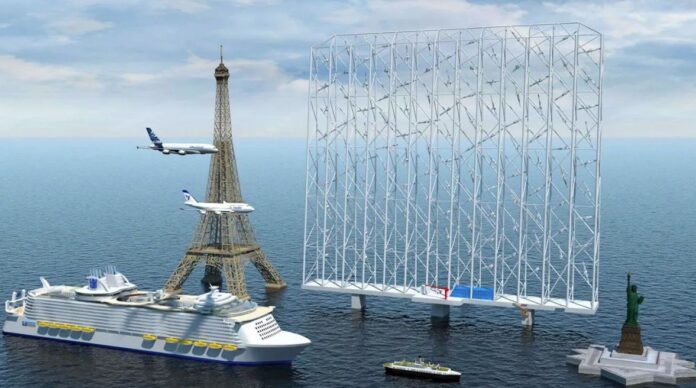Wind catchers are devices designed to catch the wind. They are a common Middle East architectural feature that can cool a home through cross ventilation and passive cooling. But the wind catchers I am writing about today are multiple wind turbine giant arrays that float in the ocean churning out hundreds of Megawatts of energy.
Wind Catching Systems is a Norwegian company founded in 2017 that is the developer of these novel wind turbine arrays. Instead of single towers supporting windmill rotors hundreds of metres across, the company has designed arrays that are 324 metres (1,000 feet) tall, containing 126 small wind turbines and generating as much energy as five standalone conventional wind power systems today, Because of their height, Wind Catchers take advantage of higher-altitude wind conditions. Their design provides greater energy capacity and structural flexibility to allow them to operate far from shore in places where conventional turbines dare not go.
In the last week, the company won Fast Company’s Innovation by Design Award in the Sustainability category. Designed specifically to float, each Wind Catcher provides a platform that is easy to maintain, eliminating the need for service boats to provide support. The self-contained array reduces the amount of ocean surface needed per Kilowatt-hour of electricity produced.
The first operational array is expected to go into service in 2024 producing five times more energy than any existing wind turbine. In using smaller rotors and because of its height each Wind Catcher takes advantage of higher wind and rotational speeds.
In June Wind Catching Systems received $10 million USD from General Motors. The investment will help the new company develop its supply chain to mass produce the arrays.
States Ole Heggheim, the company’s CEO, “The turbine system today is a very complicated machine. We’re trying to make it as uncomplicated as possible.” The company hopes to win widespread adoption by offshore wind operators and developers looking to produce electricity at costs that compete with other energy sources and without the need for government subsidies.
Each Wind Catcher is designed to last 50 years without requiring significant maintenance. Compare that to the 30-year average lifespan of conventional wind turbines. And because of the design, Wind Catchers will be easier to manufacture, easier to maintain on location, and easier to recycle at the end of their operational life. One Wind Catcher is rated to produce from 75 to 126 Megawatts of electrical power. That’s enough capacity to power 80,000 homes.
Why did the founders choose to go the multi-turbine route? They looked at the basic design being used in offshore wind production and noted that it became far less efficient when put on a floating platform. That’s why they looked to create something lighter, more flexible, and capable of producing much higher energy yields in a small amount of space. That led to the multi-turbine array that is the Wind Catcher today. In modelling the founders were impressed with the energy yield from a multitude of small turbines.
Their first test was a Wind Catcher mounted on a trimaran. From there they scaled up to the Wind Catcher design seen in the image above. Scaling potential has yet to reach its upper limit with future designs even larger than those to be deployed in 2024.
Beyond the General Motors investment, the company has received backing from Innovation Norway, and Norwegian investors Ferd and North Energy. If all goes well it should have a transformational impact on the offshore wind energy sector.

















[…] at renewable over-water solutions. The article I wrote and published in September featured the Wind Catcher, a floating array of small wind turbines designed to endure for a half-century with minimal […]
[…] September 2022, I wrote about the Windcatcher, a novel wind turbine design seen in the picture […]